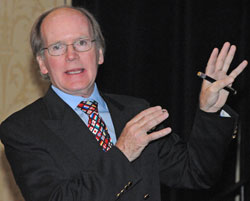 Wrapping up the Global Dairy 500 Conference was Dr. Pearse Lyons, Alltech President. Dr. Lyons summarized many of the presentations with a series of take home messages. The focus was on the future of dairy farming, the integration of a brand, methane production, cow comfort, tourist attractions, education, milk marketing with nutrition also being a key topic. Additionally, a strong message that came out of the presentations was to “record the data” and that body conditioning is critical. As Dr. Lyons said, “Talk to the cow and the cow will talk to you.”
Wrapping up the Global Dairy 500 Conference was Dr. Pearse Lyons, Alltech President. Dr. Lyons summarized many of the presentations with a series of take home messages. The focus was on the future of dairy farming, the integration of a brand, methane production, cow comfort, tourist attractions, education, milk marketing with nutrition also being a key topic. Additionally, a strong message that came out of the presentations was to “record the data” and that body conditioning is critical. As Dr. Lyons said, “Talk to the cow and the cow will talk to you.”
During his closing remarks Dr. Lyons introduced the Agri Aware program that Alltech has sponsored. The educational program for school children of all ages now has it’s first video module featuring “A Day in the Life of a Dairy Farmer.” We watched the video and then Dr. Lyons called on participants to go back home, take the program and have it translated into their languages.
You can listen to Dr. Lyons remarks below. And don’t forget to check out my photo album from the event. If you didn’t attend you can see what you missed!
2009 Global Dairy 500 Conference Photo Album
AgWired coverage of the Global Dairy 500 Conference is sponsored by  .
.


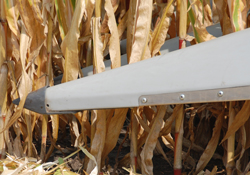 USGC is encouraging all farmers to carry a camera in the combine this year to snap some photos of the harvesting of food, feed and fuel for the United States and abroad. Each photo will be entered for a free Council meeting registration for our 7th International Marketing Conference and 50th Annual Membership Meeting in Puerto Vallarta, Mexico, Feb. 13-17, 2010. Enter more than one photo to increase your chances of winning!
USGC is encouraging all farmers to carry a camera in the combine this year to snap some photos of the harvesting of food, feed and fuel for the United States and abroad. Each photo will be entered for a free Council meeting registration for our 7th International Marketing Conference and 50th Annual Membership Meeting in Puerto Vallarta, Mexico, Feb. 13-17, 2010. Enter more than one photo to increase your chances of winning!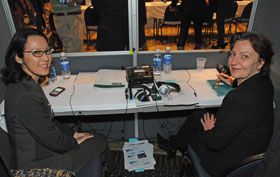 At an international conference like the Global Dairy 500 Conference translators are absolutely necessary. We have many of them here. During a break this morning I spoke with Irina Zablith (right) who is not only a translator but a veterinarian from Brazil. She’s translating into Portugese.
At an international conference like the Global Dairy 500 Conference translators are absolutely necessary. We have many of them here. During a break this morning I spoke with Irina Zablith (right) who is not only a translator but a veterinarian from Brazil. She’s translating into Portugese.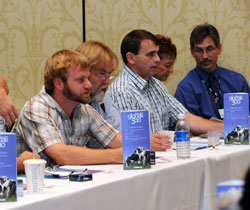 You need go no further than any dairy farmer here at the Global Dairy 500 Conference to know that the big issue is money. Take Daniel Williams, seated to the left in the photo. Daniel has an 800 cow dairy in Madison, GA.
You need go no further than any dairy farmer here at the Global Dairy 500 Conference to know that the big issue is money. Take Daniel Williams, seated to the left in the photo. Daniel has an 800 cow dairy in Madison, GA. This is what the moon looked like tonight after a full day of the Global Dairy 500 Conference. This is a hand held shot on the way back from the Alltech Lexington Brewery.
This is what the moon looked like tonight after a full day of the Global Dairy 500 Conference. This is a hand held shot on the way back from the Alltech Lexington Brewery. More than 3,000 international scientists, professionals, educators, and students will present new technologies and discuss emerging trends in agriculture, energy, climate change, carbon trading, science education, and related issues at the event November 1-5 at the David L. Lawrence Convention Center. Other informative sessions will focus on nutrition, wines, food security, invasive species, organic agriculture, hazardous waste, plant breeding, and turfgrass science.
More than 3,000 international scientists, professionals, educators, and students will present new technologies and discuss emerging trends in agriculture, energy, climate change, carbon trading, science education, and related issues at the event November 1-5 at the David L. Lawrence Convention Center. Other informative sessions will focus on nutrition, wines, food security, invasive species, organic agriculture, hazardous waste, plant breeding, and turfgrass science.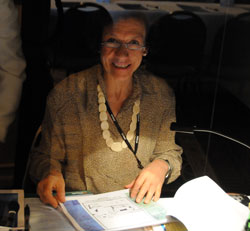 The Global Dairy 500 Conference is a truly international one. There are farmers here from all over the world which requires a lot of translators who are working very hard in their booths at the back of the conference presentation rooms.
The Global Dairy 500 Conference is a truly international one. There are farmers here from all over the world which requires a lot of translators who are working very hard in their booths at the back of the conference presentation rooms.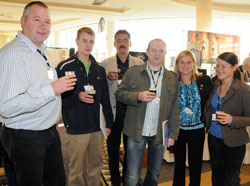 In the middle of this happy group is Henry. He spoke very good English so he got volunteered to speak with me. He has about 450 dairy cows and also row crops on his farm. He says he’s always on the search for new technology because it will make him more efficient. Henry echoes a comment I’ve heard a number of times today and that is that dairy farmers globally are suffering with the same problems, namely the price of milk.
In the middle of this happy group is Henry. He spoke very good English so he got volunteered to speak with me. He has about 450 dairy cows and also row crops on his farm. He says he’s always on the search for new technology because it will make him more efficient. Henry echoes a comment I’ve heard a number of times today and that is that dairy farmers globally are suffering with the same problems, namely the price of milk.